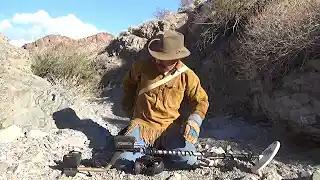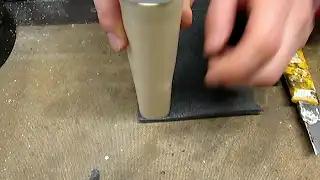best reviews metal detectors for gold
Interesting information about treasure hunters
In recent years, the technique used in search operations is becoming more sophisticated, allowing you to make unexpected discoveries even for those who first picked up a treasure detection device. It is known that in 2009, an English amateur archaeologist, using a metal detector to search for gold, accidentally found on his friend’s farm a treasure from the Anglo-Saxon era, which included gold products, lats, weapons, church supplies, gems and silver jewelry. The following year, a treasure hunter in the same UK found 1.5 centners of ancient coins that were in the thickness of the earth at a depth of only 0.3 m.
At its core, a metal detector is a device that distinguishes the presence of metal underground without direct contact with it. Such devices emit certain waves and take response data, informing the search engine about the find by means of sound or visual signal. When connected in the search tip of the device, electromagnetic fields are generated, which spread and interact with various substances.
When in contact with metals on their surface there are vortex currents that reduce the own electromagnetic field of the metal detector, which is fixed by electronic components and transmitted as a signal. The metal components in the found object are identified based on the measurement of its specific electrical conductivity. Metal detectors can have different types of radiation for radio waves, different methods of capturing the reverse signal and processing it, some additional functions, and their price depends on it. Before you buy the device, you need to decide what you are going to do with it.
How the device works
At its core, a metal detector is a device that distinguishes the presence of metal underground without direct contact with it. Such devices emit certain waves and take response data, informing the search engine about the find by means of sound or visual signal. When connected in the search tip of the device, electromagnetic fields are generated, which spread and interact with various substances.
When in contact with metals on their surface there are vortex currents that reduce the own electromagnetic field of the metal detector, which is fixed by electronic components and transmitted as a signal. The metal components in the found object are identified based on the measurement of its specific electrical conductivity. Metal detectors can have different types of radiation for radio waves, different methods of capturing the reverse signal and processing it, some additional functions, and their price depends on it. Before you buy the device, you need to decide what you are going to do with it.
Modern search equipment works at very low frequencies (VLFs), which allows you to effectively recognize the parameters of the find. Metal detectors usually operate with frequencies of 6 to 20 kHz. But to search for gold will need special variants with a frequency range of 14-20 kHz or more, as it requires increased sensitivity to small elements (for example, tiny nuggets). In addition, multi-frequency search devices can be used to increase the number of objects being recognized.
Experts believe that from the schemes on which metal detectors are built, it is necessary to pay attention to devices with balanced induction, which have two coils in the head, which have a powerful electronic scheme, allowing to determine the depth conductivity of found metals, etc.
Good and samples with the principle of work “receiver-transmitter” (excluding equipment with a lower threshold of frequencies), which work at frequencies of about 20 kHz and allow to distinguish black metal samples from non-ferrous, while eliminating the signal from the ground and debris.
There are metal detectors with working frequencies of 50 to 500 kHz, where the receiving and transmitting coil are located at an angle of 90 degrees relative to each other (radio frequency). They are good for finding large items (larger than a litre can by volume) in low-mineralized soil. The device does not distinguish between types of metals and small parts, so it is not suitable for finding gold.
Another type of search equipment is metal detectors with the principle of PI - pulse induction. They are the most sensitive to the detection of small objects, do not require adjustment, well adjusted from the signals transmitted by soils (virtually all soils have elements of iron and other metals), easy to use. However, many of them have too low frequencies (50-399 Hz), consume a lot of energy and poorly recognize types of metals.
Universal. They work on the principle of “transmitter-receiver” with balancing induction. Coins and decorations can be found at depths of up to 0.4 m and large objects located underground at a depth of up to 1.5 m. Coils for transmission/reception are in the same plane, the diameter of the head is between 10 cm and 0.4 m, the most common - 0.2 m.
Locator type. Tuned to search for the required metal, apply the effect of molecular resonance, read the area in a radius of 100 m and at depths of up to 10 m, suitable for operational search in large areas.
It’s diligent. Usually, they are equipment with the principle of “transmitter receiver” operating at a specially set frequency, which allows you to find small nuggets.
In addition to the above types, there are also security, construction, deep options, which to search for precious metals are not very relevant because of their technical characteristics.
The price of search devices in the modern market can be as much as 3000 rubles, and 0.2 million (best models). For example, the Golden King DPR Plus model, worth 210,000 rubles, is a 32-bit radar. It can be used to visualize the found object in graphic mode on the screen, including underground voids. The device is equipped with a video camera with night mode and the ability to work under water, a sensor of the presence of methane in the air. Radar has a general purpose antenna with a depth of 4 m and a deep antenna, which can find objects at a depth of up to 6 m. The device distinguishes all metals, effectively weeds out metal debris, gives a great signal of stereo quality at the temperature discovery of the find.
But experienced search engines do not advise to chase for superfluous functions in the purchased product, as especially beginners additional settings may not be useful. About 92% of the finds were found at the depth of the shovel bayonet, so they could be found as an expensive device and a metal detector, the price of which is low.
Experts believe that from the schemes on which metal detectors are built, it is necessary to pay attention to devices with balanced induction, which have two coils in the head, which have a powerful electronic scheme, allowing to determine the depth conductivity of found metals, etc.
Good and samples with the principle of work “receiver-transmitter” (excluding equipment with a lower threshold of frequencies), which work at frequencies of about 20 kHz and allow to distinguish black metal samples from non-ferrous, while eliminating the signal from the ground and debris.
Different types of devices
The devices are designed for different depth of search
There are metal detectors with working frequencies of 50 to 500 kHz, where the receiving and transmitting coil are located at an angle of 90 degrees relative to each other (radio frequency). They are good for finding large items (larger than a litre can by volume) in low-mineralized soil. The device does not distinguish between types of metals and small parts, so it is not suitable for finding gold.
Another type of search equipment is metal detectors with the principle of PI - pulse induction. They are the most sensitive to the detection of small objects, do not require adjustment, well adjusted from the signals transmitted by soils (virtually all soils have elements of iron and other metals), easy to use. However, many of them have too low frequencies (50-399 Hz), consume a lot of energy and poorly recognize types of metals.
Metal detectors for gold search are the following types:
Universal. They work on the principle of “transmitter-receiver” with balancing induction. Coins and decorations can be found at depths of up to 0.4 m and large objects located underground at a depth of up to 1.5 m. Coils for transmission/reception are in the same plane, the diameter of the head is between 10 cm and 0.4 m, the most common - 0.2 m.
Locator type. Tuned to search for the required metal, apply the effect of molecular resonance, read the area in a radius of 100 m and at depths of up to 10 m, suitable for operational search in large areas.
It’s diligent. Usually, they are equipment with the principle of “transmitter receiver” operating at a specially set frequency, which allows you to find small nuggets.
In addition to the above types, there are also security, construction, deep options, which to search for precious metals are not very relevant because of their technical characteristics.
If you decide to buy a metal detector
The price of search devices in the modern market can be as much as 3000 rubles, and 0.2 million (best models). For example, the Golden King DPR Plus model, worth 210,000 rubles, is a 32-bit radar. It can be used to visualize the found object in graphic mode on the screen, including underground voids. The device is equipped with a video camera with night mode and the ability to work under water, a sensor of the presence of methane in the air. Radar has a general purpose antenna with a depth of 4 m and a deep antenna, which can find objects at a depth of up to 6 m. The device distinguishes all metals, effectively weeds out metal debris, gives a great signal of stereo quality at the temperature discovery of the find.
The dashboard shows the dimensions and parameters of the found part
But experienced search engines do not advise to chase for superfluous functions in the purchased product, as especially beginners additional settings may not be useful. About 92% of the finds were found at the depth of the shovel bayonet, so they could be found as an expensive device and a metal detector, the price of which is low.
Experts believe that for novice treasure hunters a good option can be White Coinsmaster (Pro), which detects a five-penny coin of the USSR at a depth of a quarter of a meter, Catherine’s penny - at a depth of up to a third of a meter. The price for this product is about 11-12 thousand rubles. A metal detector from Garrett’s specialised company, the Ace 250 brand, is considered a good one. You can use it to search for all metals, as well as coins, relics, jewelry made of gold and silver, as well as set custom settings. At the price it is located in the same range as the White Koinmaster, has a light weight (just over a kilogram), is easy to control, has a rapid response, can be refitted with a more powerful coil.
The price for another device for beginners is slightly higher - about 14-16 rubles. However, the X Terra-305 from Minelab already has an expanded range of functions, including two working frequencies (7.5 kHz for deep purposes and 18.75 kHz for small purposes), ground setting, rebuilding from possible electrical interference, a 12-point scale discrimination, each level of which has its own tone. This device can be equipped with additional types of coils.
Before buying an advanced metal detector for gold, you need to understand one very important truth that the search for gold is actually not the equipment, but the person himself, and the results depend on its features and abilities. For example, equipment from Garrett brand At Pro (price about 27-28 thousand rubles) can give signals in both binary audio and professional mode. This means that in professional mode, the device will give different signals for objects lying at different depths, rather than monotonous “peaks.” The question is whether the operator will be able to properly perceive and interpret them in order to excavate in the right place.
With this panel, you can customize the device to certain search options
A metal detector is equipment that needs to be customized with your own hands, to your own needs. For example, the same Garrett At Pro can be loaded into Roll Audio mode, which allows you to sift the ring-shaped iron in the form of pucks, snouts, but do not miss, for example, coins (the device squeaks repeatedly when it finds the puck, and once when it finds money) . In addition, you can set one level of sensitivity out of the 8 offered and manual or automatic calibration on the ground.
The waterproofness of the above metal detector allows it to be used in bathing areas to detect lost items at a depth of up to 3 m. And the signal in this case in the water environment will be different from the signals on land, which will require acquisition a certain personal experience for successful finds and setting the device on fresh or salty liquid.
Gold-based metal detectors are often configured by installing a high level of iron discrimination in the settings, which avoids the detection of nails and other things and does not waste time on them.
You must set up the metal detector in accordance with the attached detailed instructions, which specify all the functions. After that, you need to conduct field tests, during which you learn to “communicate” with your electronic assistant in search of treasure. To do this, it is recommended to first train in the air - to drive the device over different coins, products from precious metals. Then bury these same objects in the ground at different depths and retest to understand how the signal and its perception has changed. This is a way to set up a metal detector in general terms.
Online, it is quite common to find information about how you can make a metal detector with your own hands, including diagrams, parts, elements for rations, the process of making a coil, for example, from epoxy resin. Making the device is possible, but professionals believe that the received copy will be in its quality inferior to even the cheapest factory counterparts, as the main secret of good search devices lies in the software and thin production setup.
And finally. Before looking for gold, any novice treasure hunter should get an off-road vehicle, knowledge of the basics of life safety, detailed maps of the area where the research will be conducted, and and a compass that you need to be able to use. In addition, it is recommended to study data on fairs, extinct settlements of past centuries, etc. to find a good site.
The price for another device for beginners is slightly higher - about 14-16 rubles. However, the X Terra-305 from Minelab already has an expanded range of functions, including two working frequencies (7.5 kHz for deep purposes and 18.75 kHz for small purposes), ground setting, rebuilding from possible electrical interference, a 12-point scale discrimination, each level of which has its own tone. This device can be equipped with additional types of coils.
How to set up equipment
Before buying an advanced metal detector for gold, you need to understand one very important truth that the search for gold is actually not the equipment, but the person himself, and the results depend on its features and abilities. For example, equipment from Garrett brand At Pro (price about 27-28 thousand rubles) can give signals in both binary audio and professional mode. This means that in professional mode, the device will give different signals for objects lying at different depths, rather than monotonous “peaks.” The question is whether the operator will be able to properly perceive and interpret them in order to excavate in the right place.
With this panel, you can customize the device to certain search options
A metal detector is equipment that needs to be customized with your own hands, to your own needs. For example, the same Garrett At Pro can be loaded into Roll Audio mode, which allows you to sift the ring-shaped iron in the form of pucks, snouts, but do not miss, for example, coins (the device squeaks repeatedly when it finds the puck, and once when it finds money) . In addition, you can set one level of sensitivity out of the 8 offered and manual or automatic calibration on the ground.
The waterproofness of the above metal detector allows it to be used in bathing areas to detect lost items at a depth of up to 3 m. And the signal in this case in the water environment will be different from the signals on land, which will require acquisition a certain personal experience for successful finds and setting the device on fresh or salty liquid.
Gold-based metal detectors are often configured by installing a high level of iron discrimination in the settings, which avoids the detection of nails and other things and does not waste time on them.
Stand-field tests and metal detectors with their own hands
You must set up the metal detector in accordance with the attached detailed instructions, which specify all the functions. After that, you need to conduct field tests, during which you learn to “communicate” with your electronic assistant in search of treasure. To do this, it is recommended to first train in the air - to drive the device over different coins, products from precious metals. Then bury these same objects in the ground at different depths and retest to understand how the signal and its perception has changed. This is a way to set up a metal detector in general terms.
Online, it is quite common to find information about how you can make a metal detector with your own hands, including diagrams, parts, elements for rations, the process of making a coil, for example, from epoxy resin. Making the device is possible, but professionals believe that the received copy will be in its quality inferior to even the cheapest factory counterparts, as the main secret of good search devices lies in the software and thin production setup.
And finally. Before looking for gold, any novice treasure hunter should get an off-road vehicle, knowledge of the basics of life safety, detailed maps of the area where the research will be conducted, and and a compass that you need to be able to use. In addition, it is recommended to study data on fairs, extinct settlements of past centuries, etc. to find a good site.
The man with the metal detector: the finds will be enough for hundreds of years
What to find with a metal detector
Metal detector with your own hands. Detailed instructions with diagrams
Powerful Pirat metal detector with his own hands
Metal detector BU how to check
Search for gold with a metal detector
If the police came to your cop. What to do?
Metal detectors
What is a metal detector and how it works
How the metal detector works and more for beginners
What is a metal detector and how does it work?
How manual and arched metal detector works
Best metal detector for gold
Iskateli Collectors Store Chain
Choosing a metal detector to find gold
Tune Minelab X-Terra 705
How to set up a Garrett AT Pro metal detector
What can be found with a metal detector?
What can be found with a ground metal detector
Options for balancing the ground of metal detectors
What benefits can be brought to treasure hunters of downpours
What can you find with a metal detector?
How to use a metal detector and what to find
What can i find with a metal detector?
Looking for a treasure without a metal detector
Finds that can be made with a metal detector
Is it possible to find a treasure in Estonia and what to do if something valuable has fallen into your hands?
Named places where in the suburbs with a high probability you can find a treasure
What and where can be found with a metal detector?
Homemade metal detectors, or how to make a metal detector with your own hands
Search for hoards with a metal detector, the 2015 season is not closed yet
What is a metal detector and why it is needed
Improvised coil for pulsed metal detector
Search for metal detector-free coins
Where to look for coins metal detector
Instructions for the Garrett Ace 250 metal detector
What is a metal detector
What to find with a metal detector
Metal detector with your own hands. Detailed instructions with diagrams
Powerful Pirat metal detector with his own hands
Metal detector BU how to check
Search for gold with a metal detector
If the police came to your cop. What to do?
Metal detectors
What is a metal detector and how it works
How the metal detector works and more for beginners
What is a metal detector and how does it work?
How manual and arched metal detector works
Best metal detector for gold
Iskateli Collectors Store Chain
Choosing a metal detector to find gold
Tune Minelab X-Terra 705
How to set up a Garrett AT Pro metal detector
What can be found with a metal detector?
What can be found with a ground metal detector
Options for balancing the ground of metal detectors
What benefits can be brought to treasure hunters of downpours
What can you find with a metal detector?
How to use a metal detector and what to find
What can i find with a metal detector?
Looking for a treasure without a metal detector
Finds that can be made with a metal detector
Is it possible to find a treasure in Estonia and what to do if something valuable has fallen into your hands?
Named places where in the suburbs with a high probability you can find a treasure
What and where can be found with a metal detector?
Homemade metal detectors, or how to make a metal detector with your own hands
Search for hoards with a metal detector, the 2015 season is not closed yet
What is a metal detector and why it is needed
Improvised coil for pulsed metal detector
Search for metal detector-free coins
Where to look for coins metal detector
Instructions for the Garrett Ace 250 metal detector
What is a metal detector
Video how to make a metal detector
Where to look for a metal detector
Where to look with a metal detector
Where to dig with a metal detector by law
Where to find a metal detector
Where to look for a metal detector
Where to find a metal detector
What a metal detector is for
How to choose a metal detector
How to choose a metal detector to search
How to look without a metal detector
How to look for a metal detector
What's the name of the metal detector
How to find gold metal detector
How to find metal detector
How to set up a metal detector
How to set up a metal detector
How to set up a garrett metal detector
How to set up a metal detector x terra 705
How to set up a metal detector garrett
How to set up a metal detector
How to check the metal detector
How to pass a metal detector
How the metal detector works
As a metal detector itself
How to make a metal detector at home
How to make a reel on a metal detector
How to make a metal detector pirate
How to make a metal detector with your hands at home
How to make a powerful metal detector
How to make a simple metal detector
How to make a homemade metal detector
How to assemble a metal detector pirate
Stores where metal detectors are sold
Metal detector for gold how to choose
Metal detector how to choose to search for gold
What to find a metal detector
What they find as a metal detector
What is a metal detector
Where to look for a metal detector
Where to look with a metal detector
Where to dig with a metal detector by law
Where to find a metal detector
Where to look for a metal detector
Where to find a metal detector
What a metal detector is for
How to choose a metal detector
How to choose a metal detector to search
How to look without a metal detector
How to look for a metal detector
What's the name of the metal detector
How to find gold metal detector
How to find metal detector
How to set up a metal detector
How to set up a metal detector
How to set up a garrett metal detector
How to set up a metal detector x terra 705
How to set up a metal detector garrett
How to set up a metal detector
How to check the metal detector
How to pass a metal detector
How the metal detector works
As a metal detector itself
How to make a metal detector at home
How to make a reel on a metal detector
How to make a metal detector pirate
How to make a metal detector with your hands at home
How to make a powerful metal detector
How to make a simple metal detector
How to make a homemade metal detector
How to assemble a metal detector pirate
Stores where metal detectors are sold
Metal detector for gold how to choose
Metal detector how to choose to search for gold
What to find a metal detector
What they find as a metal detector
What is a metal detector
Comments & Responses
Leave a Reply
Your email address will not be published. Required fields are marked *
Comment
Leave a Reply
Your email address will not be published. Required fields are marked *
Comment
Name *
Email *
Website
What is a metal detector and how it works
How the metal detector works and more for beginners
What is a metal detector and how does it work?
How manual and arched metal detector works
Best metal detector for gold
What can be found with a metal detector?
What can be found with a ground metal detector
Options for balancing the ground of metal detectors
What benefits can be brought to treasure hunters of downpours
What can you find with a metal detector?
How to use a metal detector and what to find
What can i find with a metal detector?
Looking for a treasure without a metal detector
Finds that can be made with a metal detector
Is it possible to find a treasure in Estonia and what to do if something valuable has fallen into your hands?
Named places where in the suburbs with a high probability you can find a treasure
What and where can be found with a metal detector?
How the metal detector works and more for beginners
What is a metal detector and how does it work?
How manual and arched metal detector works
Best metal detector for gold
What can be found with a metal detector?
What can be found with a ground metal detector
Options for balancing the ground of metal detectors
What benefits can be brought to treasure hunters of downpours
What can you find with a metal detector?
How to use a metal detector and what to find
What can i find with a metal detector?
Looking for a treasure without a metal detector
Finds that can be made with a metal detector
Is it possible to find a treasure in Estonia and what to do if something valuable has fallen into your hands?
Named places where in the suburbs with a high probability you can find a treasure
What and where can be found with a metal detector?





